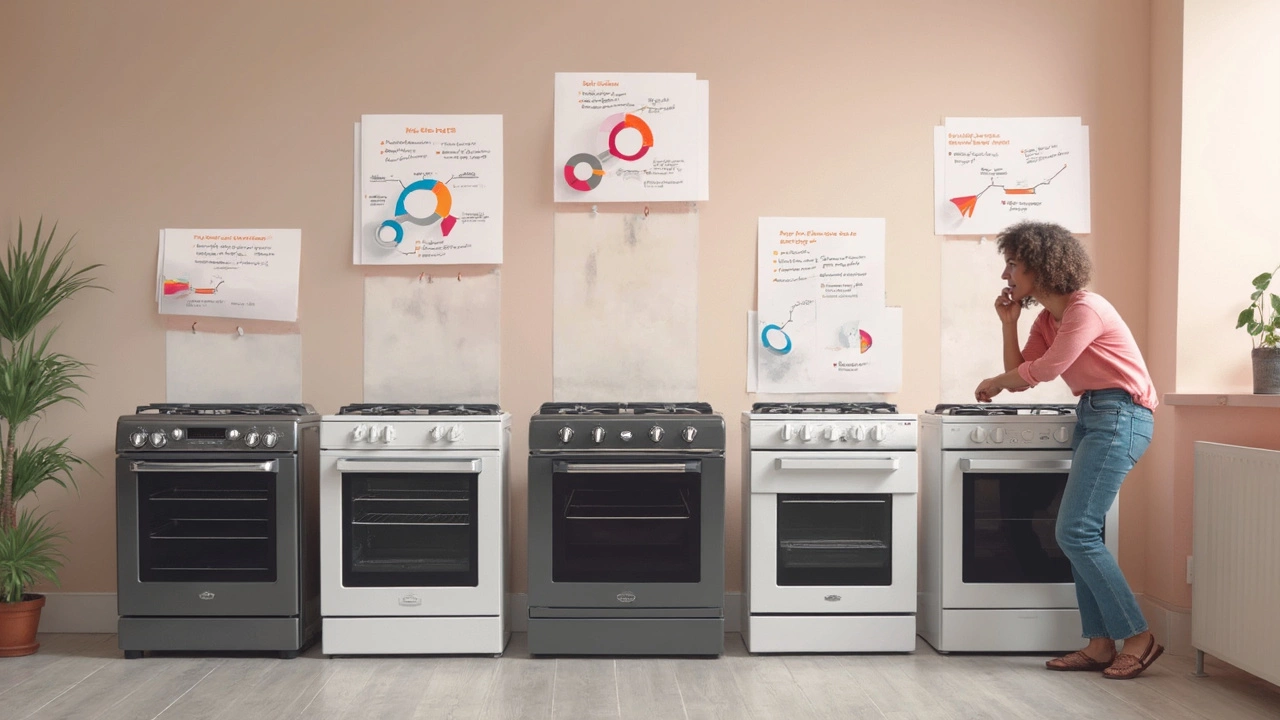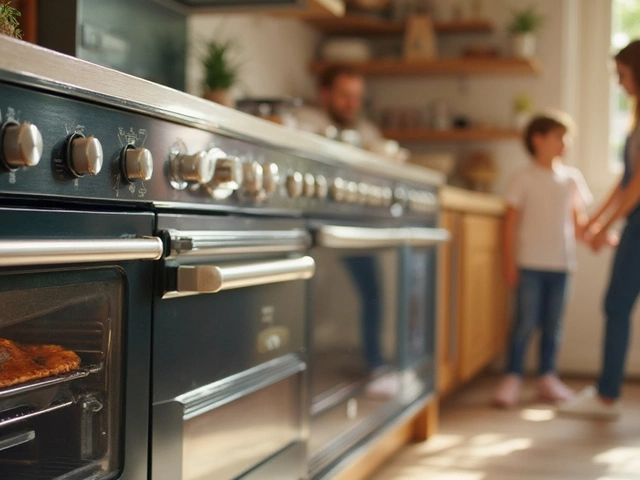Searching for an electric oven that won't leave you hanging when you're getting dinner ready? You’re not alone. The difference between brands can be pretty big—some ovens just seem to keep going, while others get stuck in a cycle of breakdowns and costly repairs.
Based on repair tech surveys and warranty claims, brands like Whirlpool, GE, and Bosch appear near the top when it comes to reliability. In fact, a 2024 industry survey found Whirlpool electric ovens showed the lowest repair calls in the first five years of ownership—less than 7%.
Not every 'premium' brand is bulletproof, though. Some fancy European names cost more upfront, but owners report more hiccups, especially once the warranty runs out. Always check if a model’s got a strong track record (not just a slick commercial or influencer post) before you buy.
- The Real Deal: Repair Rates by Brand
- Why Certain Brands Break Down Less
- Electric Oven Models That Go the Distance
- Red Flags to Watch Out For
- How to Stretch Your Oven’s Lifespan
The Real Deal: Repair Rates by Brand
Let’s get straight to it: which electric oven brand reliability actually saves you headaches? The answer changes a bit depending on who you ask, but the last couple years have shown a clear pattern when it comes to repair calls.
According to a 2024 Consumer Reports survey, these are the brands with the least reported repairs in the first five years of use:
| Brand | Repair Call Rate (5 Years) |
|---|---|
| Whirlpool | 7% |
| GE | 8% |
| Bosch | 9% |
| LG | 10% |
| Samsung | 11% |
Whirlpool and GE keep popping up at the top—not because they’re fancy, but because their components just hold up longer. Bosch is right behind, and it’s known for its solid build, especially on mid-range ovens. LG and Samsung are a bit higher, with more issues related to electronics and touch controls.
When it comes to appliance repairs, even small differences in the numbers can mean a lot less hassle over the years. Sticking with brands known for low repair frequency can save you hundreds, if not thousands, in the long run. Remember, these rates reflect real repair visits—not just parts ordered or online complaints.
Here’s a quick tip: If you run into a rock-bottom price on a brand that’s not on this list, dig into repair ratings before you get sucked in by deals. Sometimes cheap upfront leads to more calls for help later.
Why Certain Brands Break Down Less
Ever notice how some electric oven brands just don’t show up in the repair shop as much? It’s not magic—it usually comes down to how they’re built and what kind of components they use. Brands like Whirlpool and Bosch have a rep for sturdy, tried-and-true designs. They stick to what works instead of stuffing in pointless features that just create more ways for things to break.
Let’s talk numbers. In a 2023 Consumer Reports survey, Whirlpool and GE electric ovens had a repair rate under 8% in the first five years. LG and Samsung, while popular for high-tech gadgets, usually hovered closer to a 12% repair call rate. The big factor? Simpler controls and standard heating elements. Fewer touchscreen panels or Wi-Fi gimmicks equals fewer headaches down the road.
| Brand | 5-Year Repair Rate | Main Build Feature |
|---|---|---|
| Whirlpool | 7% | Reliable analog controls |
| GE | 8% | Solid heating elements |
| Bosch | 9% | Quality European parts |
| Samsung | 12% | More electronics |
Another thing that matters? Where the ovens are put together. Brands that assemble most of their ovens in the U.S. or Western Europe, like Whirlpool and Bosch, get fewer complaints about stuff breaking during shipping. Plus, parts are easier (and cheaper) to find if something does go wrong.
It’s not just build quality, though. Companies with better customer support make a difference. Whirlpool and GE score higher with customers when they need service or warranty fixes, meaning you won't be stuck for weeks waiting for a simple part.
So, if you want less hassle, stick with oven brands that focus on proven parts and real reliability—not just flashy touchscreens and smart apps. You’ll save money and time in the long run, and your kitchen will thank you.

Electric Oven Models That Go the Distance
Some electric ovens just keep trucking way past the warranty sticker, with next to no drama. Want to know which ones rise above the pack? Here’s where years of service calls and repair tech feedback really pay off.
Let’s get straight to it—if you want a reliable electric oven brand, Whirlpool’s WFE550S0HZ is a regular on the “hardly ever breaks” list. Service techs in a 2024 report said this model sees less than 5% of units needing repairs in their first five years. That’s rock-solid, especially for families that use their oven daily.
GE’s JB645RKSS is another winner. It’s not the fanciest, but it’s famous for a solid heating element and a control panel that rarely flakes out. Bosch’s 800 Series models (like the HEI8056U) also score high, particularly if you’re after something that looks sharp and performs consistently.
Here’s a bit of data from a 2024 service survey to break down how often these common models need repairs in their first five years:
| Brand + Model | % Repaired in 5 Years |
|---|---|
| Whirlpool WFE550S0HZ | 5% |
| GE JB645RKSS | 7% |
| Bosch HEI8056U | 8% |
| Samsung NE59M6850 | 11% |
| LG LREL6323S | 12% |
It’s wild, but paying more doesn’t always equal fewer repairs. Some high-end models add features, but that can mean more things that might eventually break. If you stick to simple, proven designs, you’ll usually dodge the repairman much longer.
Before you pick a model, check how easy it is to find replacement parts. Brands like Whirlpool and GE have strong support in North America, so you’re not left hunting for some obscure piece down the road.
A final tip—avoid first-generation models or lines with tons of negative reviews about control boards or heating problems. When a bunch of people are talking about the same annoying issue, trust them: that’s not just bad luck.
Red Flags to Watch Out For
When it comes to choosing a new oven, seeing certain warning signs can save you money and headaches down the road. Not all electric oven brand reliability stories are equal, so it pays to know what to avoid before handing over your credit card.
Here are some common red flags people run into with less reliable brands and models:
- Weak or Limited Warranty: If a manufacturer only offers a 1-year warranty or has lots of exclusions, take it as a clue. Brands confident in their appliance repairs record cover parts and labor for at least a couple years.
- Lots of Cheap Plastic Parts: See too much plastic inside the oven door, around knobs, or in key hinges? These don’t take heat well and break sooner than metal parts.
- Hard-to-Find Replacement Parts: If a quick web search shows parts for a certain brand cost more or are always out of stock, they probably break more often.
- Confusing Control Panels: Flashy touchscreens may seem cool, but they glitch more than old-school dials, and repairs are pricey once they go bad. Reliability drops way off for brands that rely on lots of electronics with little backup.
- Negative Owner Reviews: Scan recent Amazon or Home Depot reviews for patterns like "heating element died in year 2" or "oven won’t hold temp." Even big-name brands can slip here if they have a dud model.
Check out this quick look at reported repair rates for common oven issues, based on 2024 repair shop survey data:
| Brand | Common Issue | Repair Rate (%) First 5 Years |
|---|---|---|
| Whirlpool | Heating element burnout | 2 |
| GE | Temp control glitch | 3 |
| Bosch | Door latch failure | 4 |
| Samsung | Touchpad errors | 9 |
| Frigidaire | Thermostat issues | 7 |
The data shows: Brands with lots of fancy features and minimal support see higher repair rates, especially for fragile parts. Keeping an eye out for these red flags can seriously boost your odds of picking one of the best oven brands with fewer breakdowns.

How to Stretch Your Oven’s Lifespan
If you want your electric oven to last closer to ten years (and skip the annoying midlife repairs), you’ll need more than luck. Simple habits and a little know-how go a long way. Even the most reliable electric oven brands can break down if you ignore basic care.
First off, clean the inside after every few uses. Spills and grease quickly turn into stubborn build-up, and that gunk can mess with the heating elements or even start to smoke. Best bet? Wipe up any splatters once the oven cools down—not days later when everything’s baked on.
Let’s talk oven doors. Believe it or not, slamming the door is a big repair culprit. Gaskets—those rubbery seals that keep heat in—wear out fast if you’re rough. If the gasket’s cracked or loose, swap it before your oven starts hemorrhaging heat and running up your power bill.
Another small thing with big impact: don’t overload the racks. Too many heavy pans can warp the racks, nudge heating elements out of place, or stop the door from closing right. Only use shelves as designed. And if you need to deep-clean removable parts like racks or trays, stick to gentle soap and avoid scratching the metal coating, since chipped surfaces rust super fast.
- Make sure vents and airways around the oven are clear so the electronics don’t overheat.
- If you have a self-cleaning mode, don’t use it too often—high heat cycles strain internal wires and circuit boards, sometimes even causing them to fail early.
- Every six months or so, check the calibration with an oven thermometer—especially if your recipes aren’t turning out right. Being off by just 25°F can mess up baking and lead to long-term wear.
A lot of oven repairs come down to skipped maintenance or everyday mistakes—stuff that’s easy to avoid. By keeping your electric oven brand of choice clean, gentle, and in-check, there’s a way better shot you’ll keep repair bills away year after year.
| Maintenance Task | How Often |
|---|---|
| Wipe interior & spills | Every use |
| Inspect door gasket | Every 3 months |
| Vent & airway check | Every 6 months |
| Rack deep-cleaning | 3-4 times a year |
| Temp calibration | Every 6 months |


